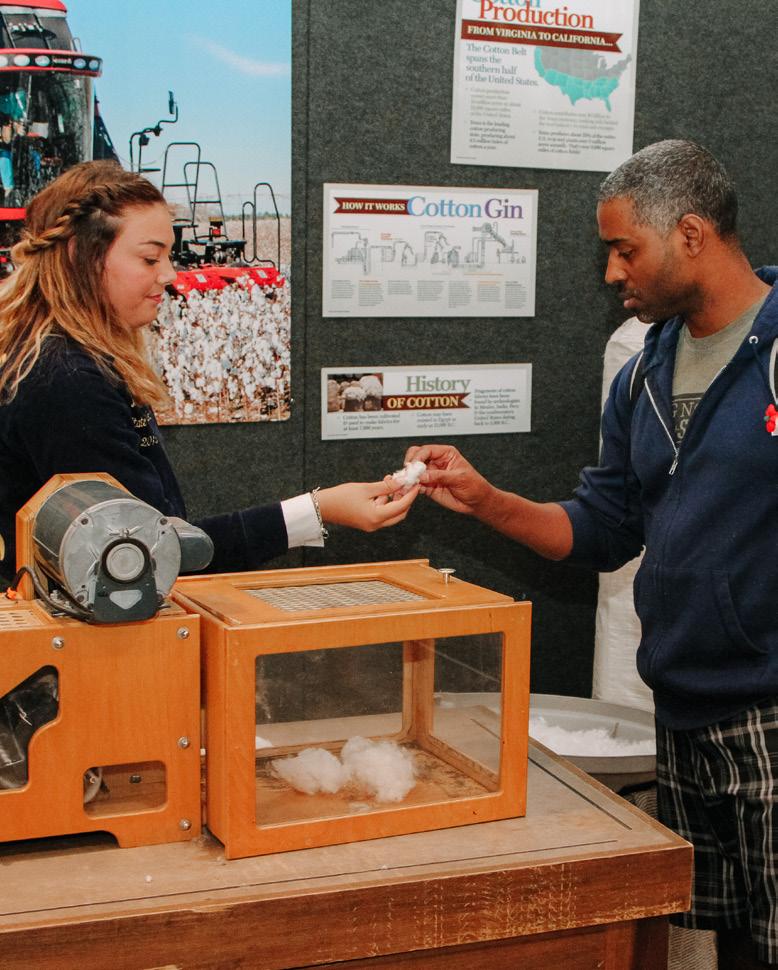
7 minute read
Advocacy: Texas FFA’s Chance to Change the World
ADVOCACY
TEXAS FFA’S CHANCE TO CHANGE THE WORLD
Advertisement
dvocacy is defined as the act or process of supporting a cause. It sounds simple and, in fact, the best approach to advocacy is to keep it simple. The most effective advocates make it a part of their lives, as simple and natural as the other routines in daily life. Agricultural advocacy was not fully developed until the internet came along and it has evolved over the last two decades. It has, however, lagged considerably behind the numbers and zeal of badly informed detractors who attack agriculture. It began with ag writers, including me, challenging the conventional wisdom which was usually not at all wise and mostly inaccurate. Sometimes, this was done forcefully. Farmers and ranchers with online savvy and media skills were an essential part of this. Those efforts moved the needle and encouraged other farm families to become more involved in telling those stories. There is no doubt we’ve made progress. Take, for example, the once hot debate of biotechnology, more commonly known as GMOs. for agricultural advocacy, though, without question, there is more work to do. Ag advocacy matured to include a kinder and gentler message and the sharing of personal experiences and stories. Most important, we learned to listen, addressing legitimate concerns. It has become very effective. There are just not enough people doing it! Now, as the third decade of the 21st century dawns, ag advocacy is poised to make a real difference. I believe the group that can make the most difference are the FFA members in every state. I’ve worked with the young leaders of the Texas FFA for many years. The core of my message to them is the guiding principle of my career – you communicate mostly by what you do. This is true more than ever today, with ever more sophisticated cell phone cameras and social media connections that make every action only seconds away from viral internet embarrassment. As in many things, careful work in building an image can be reduced to rubble at blinding speed. A
12 Mainstream media reporters once accepted the negative conventional wisdom on this topic. Once reporters started looking into it, they now almost universally conclude that the weight of science falls in favor of biotech and the farmers who use it. This was a major victory Advocacy begins with a choice to do right and serve as an example. The wholesome activities of FFA are generated by belief in a strong work ethic. Your projects, such as showing livestock and agriscience fair research, can show the world a
positive side of young people in agriculture. It is a classic example of communicating by what you do. It’s a window on our world in which the public can see agriculture in the best possible way or something less than that. Communicating with your actions means no cheating. Even worse, the one moment of frustration that leads to mistreating an animal communicates too. We all know these incidents are isolated and rare. They are often done by people who normally would never do such a thing. In fact, the incident will sometimes be made to look far worse than it actually is. With dozens of cell phone cameras nearby, it’s a potential communications nightmare. When it happens, agricultural advocates have to start over, rebuilding reputations and positive messages. All this is to say that becoming an advocate carries with it a responsibility. It’s not really all that hard, though. For most of you it’s second nature already. I would never suggest FFA kids engage detractors in angry online exchanges. That is mostly ineffective and reinforces bad habits. Instead, I recommend telling your own story online and to the mainstream media when those opportunities arise. Your messages should contain phrases like, “This is how we do it on our farm,” or “In our FFA chapter, we do it this way.” FFA contests are a way to dive deeper into the issues farmers and ranchers face daily. Sources of information are provided online by agricultural organizations, land grant universities and government. Participation in these activities will make you an effective advocate with a broad base of knowledge. “MOST IMPORTANT, WE LEARNED TO LISTEN, ADDRESSING LEGITIMATE CONCERNS. IT HAS BECOME VERY EFFECTIVE. THERE ARE JUST NOT ENOUGH PEOPLE DOING IT!” There is another way to hit the advocacy home run in your community. You should forge alliances with people who are farmers and ranchers, with farm organizations or those involved in agribusiness. Often, these folks are FFA alumni. In almost every Texas community, there are members of the Texas Farm Bureau, Texas and Southwestern Cattle Raisers, Texas Cattle Feeders, Texas Wildlife Association, and many others. This is a natural support system for FFA chapters. Many of them support your program already. What’s missing is organizing the effort. It should start with FFA members and advisers reaching out. Interaction with these groups are opportunities to see how agriculture and food policy works in the real world. The Farm Bureau, for example, is organized in 206 Texas counties. Many county Farm Bureaus give scholarships for college and sponsorships to the TFB Youth Leadership Conference. They sponsor field days and Ag-inthe-Classroom events where you can share your message with kids who may have never been exposed

We call it advocacy or “agvocacy,” but perhaps a better description is “engagement.” We seek to communicate with people who have little concept of agriculture.
Often, individuals still hold strong beliefs about that which they do not understand. We are engaging with people. It is not only a teaching experience but also a learning one.
We once were a nation that engaged via mainstream media. It was the daily paper and nightly newscast where the issues of the day were debated. It was, however, essentially one-way communication.
Thanks to the internet and social media, even those news operations are largely two-way communication vehicles, along with a host of others.
Everyone has an opinion. That’s always been true. Now, however, nearly everyone has the means to express that opinion.
Being an advocate is to know persuasive arguments, but often the overlooked element is listening. You will reach a comfort level when you develop respect of the opinions of others. The late U.S. Sen. Daniel Patrick Moynihan famously said, “You are entitled to your own opinions but not your own facts.”
Showing respect for another person’s point of view will provide openings to explain your own positions. Your personal story is the foundation of your message.
Advocacy is a learned skill, but it’s more than that. It’s a lifestyle choice. Your message is more than written words. All of you communicates. Your message comes through in your life and daily tasks. It’s the moral and ethical code you follow. It’s the mistakes you make and how you address them.
Agriculture still trails its adversaries in the number of people willing to tell their stories. FFA members standing with the other elements of modern agriculture will be a huge step forward in correcting the still formidable misconceptions and misunderstandings about agriculture.

Teach Ag Tips
APPLYING AND/OR INTERVIEWING FOR A NEW JOB SUGGESTED QUESTIONS TO ASK BY: RAY PIENIAZEK, AG TEACHERS ASSOCIATION OF TEXAS EXECUTIVE DIRECTOR
1. What are the administration’s expectations of the ag department? 2. What is the district’s vision for the agricultural education program? 3. What are the expectations of the community for this agricultural education program? a. Is there an advisory committee? b. Who are the key individuals who support the program? 4. Where does the district want this program to be in 5 years? 5. What is the length of the contract being offered? a. Is it by months or days? b. How are vacation days allotted? c. Can weekends be accounted for as a contract day? 6. How many travel days are allowed? a. Am I allotted a set number of days to be gone for school related activities? 7. What are the summer hours expected of the agricultural science teachers? 8. Is there a stipend available, and what is its designated purpose? a. What is expected to receive it? b. How will it be documented in my income - as salary or travel? c. Is it to compensate for extra hours spent after school? 9. What is the current enrollment in agricultural science classes? a. How many students are needed to make a class? b. If numbers are small will they blend multiple sections in one? c. How many students are allowed in a shop type class? 10. What is the district’s expectations on industry based certifications?








